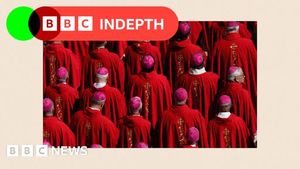On April 17, 2025, Riot Games, in collaboration with the National Heritage Administration, unveiled the results of the 'Joseon Royal Cultural Heritage Seohwaru Reproduction' project at the National Palace Museum of Korea in Jongno-gu, Seoul. This initiative, which has been supported since 2023, aims to preserve and promote significant cultural artifacts from the Joseon dynasty.
Since 2023, Riot Games has funded the reproduction of three types of cultural assets, totaling nine items, based on a sponsorship agreement signed with the National Heritage Administration in 2022. The reproduced artifacts include the 'Chaekgado Byeongpung', 'Jongmyo Jerye Gyuje Doseol Byeongpung', and 'Boso Dang Injon'.
The 'Chaekgado Byeongpung' (冊架圖 屛風) is a ten-panel folding screen that features books stacked on shelves, symbolizing the academic pursuits and intellectual heritage of the Joseon royal family. It is believed to have been created in the late 19th to early 20th century. Meanwhile, the 'Jongmyo Jerye Gyuje Doseol Byeongpung' (宗廟親祭規制圖說 屛風) was produced during the reign of King Gojong, between 1863 and 1907. This eight-panel folding screen illustrates the main buildings of Jongmyo, important food ceremonies, and arrangements for ancestral rites through pictures and text.
The 'Boso Dang Injon' (寶蘇堂印存) is a collection of seals kept in Boso-dang, the pen name of King Heonjong, the 24th ruler of Joseon. This artifact, presumed to have been made in the late Joseon period, consists of six books wrapped in wood, measuring 13.2cm in width and 20.8cm in length. It serves as a testament to the literary tastes of the Joseon royal family.
The National Heritage Administration has established academic research and scientific investigation plans for these reproduction projects, utilizing philological research and digital technology since August 2023. This meticulous approach has ensured that the reproductions are not only accurate but also reflective of the original artifacts' significance.
These reproduced cultural assets are set to be showcased in future exhibitions at the National Palace Museum of Korea, further enhancing public awareness and appreciation of Korea's rich cultural heritage.
Riot Games has a long-standing commitment to cultural heritage preservation, having signed an agreement with the National Heritage Administration in 2012. This partnership aims to promote the value of Korean cultural heritage and cultural sites. Over the years, Riot Games has supported the return of seven overseas cultural assets, starting with the 'Seokgasan Jon-do' in 2014 and continuing with the 'Gyeongbokgung Seonwonjeon Pyeongak' in 2024. The company has also aided in the preservation and re-creation of the Korean Legation building in Washington D.C. and the conservation of 15 Joseon royal tombs.
Kim Jin-ok, a senior researcher at the Cultural Heritage Technology Research Institute who oversaw the Seohwaru reproduction project, expressed concerns that the term "reproduction" might diminish the perceived value compared to "restoration." However, he emphasized that this project plays a crucial role in documenting the current state of cultural heritage while ensuring the sustainability of intangible heritage—an essential aspect of art and craftsmanship.
Kim stated, "Through the reproduction project, it is possible to record the present state of the cultural heritage and to ensure the sustainability of intangible heritage, which is the essence of art, and to reproduce the Joseon royal heritage." He highlighted that Riot Games serves as a bridge in preserving history, allowing for the continuation of traditional techniques in areas such as weaving, dyeing, and pottery.
Cho Hyuk-jin, the Korean representative of Riot Games, shared his perspective on the significance of these efforts. He noted, "In a reality where cultural heritage can be irreparably damaged over time, reproduction is an important way to preserve the life of the original and convey its value to the next generation." Cho expressed his satisfaction in collaborating with players to ensure that the lineage of Korea's precious cultural heritage continues.
The project not only highlights the importance of preserving cultural artifacts but also showcases the role of modern technology in enhancing our understanding and appreciation of historical treasures. As these reproductions make their way into public exhibitions, they will undoubtedly serve as a reminder of the rich cultural tapestry that defines Korea's past.
With the ongoing support from organizations like Riot Games, the future of Korea's cultural heritage looks promising. The collaboration between the gaming industry and cultural preservation efforts illustrates a unique synergy that can engage younger generations while honoring the historical significance of the artifacts.
As the National Palace Museum prepares to display these reproductions, visitors will have the opportunity to connect with Korea's royal history in a tangible way. The initiative not only preserves the past but also inspires future generations to appreciate and protect their cultural heritage.





